List of Important Intangible Folk Cultural Properties
This is a list of Important Intangible Folk Cultural Properties of Japan.
Criteria
- It must exemplify something original in the Japanese people's everyday life in terms of origin and content, and be typical.
- It must exemplify the process of evolution of some technique.
- It must exemplify some local characteristic.
Designated cultural properties
Manners and customs
Manufacture, livelihood
7 designations. All were designated under Criteria 1.
| Name | Date | Location | Remarks | Preservation | Image | Desig. | Ref. |
|---|---|---|---|---|---|---|---|
| Spring Hoe Festival of Higoshi Shinmei Shrine 樋越神明宮の春鍬祭 Higoshi Shinmei-gū no Haru Kuwa Matsuri |
11 February | Tamamura, Gunma | spring hoe festival; earliest record is to 1798[1] | Association for the Preservation of the Shinmeigu Harukuwa Matsuri (神明宮春鍬祭保存会) | 2002 | ||
| Bonito Fishing Festival of Kōzushima 神津島のかつお釣り行事 Kōzushima no Katsuo Tsuri Gyōji |
2 August | Kōzushima, Tokyo | bonito fishing festival | Association for the Preservation of the Monoiminanomikoto Shrine Katsuo Tsuri (物忌奈命神社かつお釣り保存会) | 1999 | ||
| Spiral Rice Planting of Sado 佐渡の車田植 Sado no Kuruma Taue |
last third of May | Sado, Niigata | seedlings are planted in a circular fashion by a trio of workers[2] | Association for the Preservation of Sado Kuruma Taue (佐渡の車田植保存会) | 1979 | ||
ja:奥能登のあえのこと oku noto no ae no koto |
December 5 and February 9 | Okunoto, Ishikawa | 1976 | ||||
| Mibu Flower Rice Planting 壬生の花田植 Mibu no Hana Taue |
first Sunday in June | Kitahiroshima, Hiroshima | colourful rice-planting ritual inscribed on the UNESCO Representative List of the Intangible Cultural Heritage of Humanity[3] | Association for the Preservation of Mibu no Hana Taue (壬生の花田植保存会) | |
1976 | |
| Farming Festival of Aso 阿蘇の農耕祭事 Aso no Nōkō Saiji |
13th day of first month and 25th day of 9th month (Aso Shrine); 16th day of first month and 23rd, 24th days of 9th month (Kuninomiyako Shrine) in old lunisolar calendar | Aso, Kumamoto | Association for the Preservation of the Aso Noko Festival (阿蘇の農耕祭事保存会) | 1982 | |||
| Tanegashima Hōman Shrine Rice planting Festival 種子島宝満神社の御田植祭 Tanegashima Hōman Jinja no otaue matsuri |
3 April | Minamitane, Kagoshima | Association for the Preservation of the Hōman Shrine Red Rice planting Festival (宝満神社赤米お田植え祭り保存会) | 2016 |
Life rituals
6 designations. All were designated under Criteria 1.
| Name | Date | Description/Remarks | Location | Image | Designated | Reference |
|---|---|---|---|---|---|---|
| Izumiyama Mountain Worship 泉山の登拝行事 Izumiyama no Tohai Gyōji |
25 July | An event in which young children between the age of 7 and 9 from the village of Izumiyama climb Mt. Nakui to worship at mountain shrines | Sannohe, Aomori | 1997 | ||
| Hata Oyamagake 羽田のお山がけ Hata no Oyamagake |
15th and 16th day of 8th month* | An event in which 7 year old boys climb nearby Hanedayama to pray for their healthy growth. | Kesennuma, Miyagi | 2000 | ||
| Kohata Banner Festival 木幡の幡祭り Kohata no Hata Matsuri |
1 December | An event in which a procession of parishioners carrying colorful banners climb Kohatayama to worship at Okitsushima and Hayama shrines. | Nihonmatsu, Fukushima | 2004 | ||
| Kawamata Coming-of-Age Ceremony 川俣の元服式 Kawamata no Genpuku Shiki |
21 January | A traditional coming of age ceremony for 20-year-old males with roots in the late Edo period. | Nikkō, Tochigi | 1987 | ||
| Iwatsuki Traditional Sumo Ring Entrance Ceremony 岩槻の古式土俵入り Iwatsuki no Koshiki Dohyōiri |
Around 21 October | A traditional sumo ring entrance ceremony performed by young boys. | Iwatsuki, Saitama | 2005 | ||
| Kasuga Groom Festival 春日の婿押し Kasuga no Muko Oshi |
14 January | A series of events held for men and women who became married in the previous year. | Kasuga, Fukuoka | 1995 |
Those dates marked with an * follow the traditional calendar.
Amusements, contests
9 designations
| Name | Criteria | Date | Remarks | Location | Image |
|---|---|---|---|---|---|
| Kariwano tug of war (刈和野の大綱引き Kariwano no ōtsuna-hiki)[4] | 1 | 15th day of 1st month in old lunisolar calendar | Daisen, Akita | — | |
| Sōma Wild horse racing (相馬野馬追 Sōma Nomaoi)[5] | 1 | July 23–25 | Sōma and Minamisōma Fukushima | 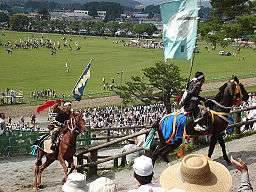 | |
| Bullfighting (牛の角突きの習俗 Ushi no tsunotsuki no shūzoku) | 1 | some time between May and November (irregular) | Nagaoka, Ojiya and Uonuma, Niigata |  | |
| Tsuruga Nishimachi tug of war (敦賀西町の綱引き Tsuruga Nishimachi no tsuna-hiki)[6] | 1 | January 14 | Tsuruga, Fukui | — | |
| Tajima Kutani tug of war (但馬久谷の菖蒲綱引き Tajima Kutani shōbu tsuna-hiki)[7] | 1 | June 5 | Shin'onsen, Hyōgo | — | |
| Inaba tug of war (因幡の菖蒲綱引き Inaba no shōbu tsuna-hiki)[8] | 1 | 5th day of 5th month and weekends before and after (Aoya); Sunday closest to the 5th day of the 5th month (Ketaka) (both dates in old lunisolar calendar); Sunday closest to June 5 (Iwami) | Iwami, Tottori (formerly Aoya and Ketaka), Tottori | — | |
| Misasa tug of war (三朝のジンショ Misasa no jinsho) | 1 | May 3 and 4 | Misasa, Tottori | — | |
| namari no momote (生里のモモテ) | 1 | Sunday closest to 1st day of 2nd month in old lunisolar calendar | Namari, Takuma, Mitoyo, Kagawa | — | |
| Yobuko tug of war (呼子の大綱引き yobuko no ōtsunahiki) | 1 | first weekend in June | Yobuko, Karatsu, Saga | — |
Social life (knowledge of folk customs)
2 designations
| Name | Criteria | Date | Remarks | Location | Image |
|---|---|---|---|---|---|
| 上州白久保のお茶講 (Jōshū-shirakubo no ochakō)[9][10] | 1 | 24 February | Local residents welcome the gods, drinking tea together, reading the tea and predicting the bounty in their lives. | Nakanojō, Gunma | — |
| 粟生のおも講と堂徒式 (Ao no omokō to dōtoshiki) | 1 | 8th day of first month in Japan's old lunisolar calendar | — |
Shimizu, Wakayama | — |
Annual functions or events
33 designations
| Name | Criteria | Type | Date | Remarks | Location | Image |
|---|---|---|---|---|---|---|
| Yoshihama Suneka (吉浜のスネカ Yoshihama no suneka)[11] | 1 | Visiting kami | 15 January | A person called "Suneka", representing a kami and dressed in a strange mask and a straw raincoat, visits each house in a given district to punish lazy or crying children; related to the Namahage tradition of Akita Prefecture; handed down in Yoshihama district, Sanriku, Ōfunato, Iwate | Ōfunato, Iwate | — |
| Tsukihama Enzu-no-wari (月浜のえんずのわり Tsukihama no Enzu-no-wari)[12] | 1 | Harvest/fertility | 11–16 January | Bird chasing procession (tori-oi) involving children; traditionally a festival to pray for abundant harvest and good health; handed down in Tsukihama district, Miyato, Higashimatsushima, Miyagi | Higashimatsushima, Miyagi | — |
| Yonekawa Mizukaburi (ablution) (米川の水かぶり Yonekawa no mizukaburi)[13] | 1 | Protection | 12 February | Event to ward off fire; young men and men of a critical age (yakudoshi, 42 years of age) dress in straw raincoats and headdresses their faces painted with soot; after a shrine visit they return to town and throw water on the houses; home owners try to extract from the participants' costumes straws which are then considered charms against fire | Tome, Miyagi | — |
| Kamigō no koshōgatsu gyōji (上郷の小正月行事)[14] | 1 | 15 January | "Little New Year" (koshōgatsu) event celebrated by children involving the burning of a hut of Sae-no-kami and a bird chasing procession (tori-oi) with singing | Nikaho, Akita | — | |
| Namahage on Oga Peninsula (男鹿のナマハゲ Oga no Namahage)[15][16] | 1 | Visiting kami | 31 December–16 January | Young men dressed in traditional straw garments and wearing large masks representing the Namahage deity visit houses of new community members urging them to work and study hard; after receiving sake and mochi they leave blessing the house | Oga, Akita |  |
| Rokugō Kamakura (六郷のカマクラ行事 Rokugō no Kamakura gyōji) | 1 | 11–15 February | snow huts | Misato, Akita | 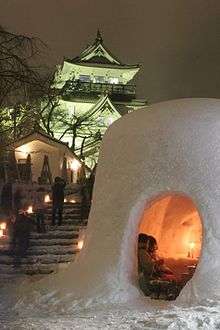 | |
| "Little New Year" event of Yuza (遊佐の小正月行事 Yuza no koshōgatsu gyōji)[17] | 1 | Visiting kami | 1, 3 and 6 January[nb 1] | A person called "Amahage", representing a kami dressed in a straw coat and covered with a red or blue ogre mask visits each family distributing mochi; also includes a tori-oi bird chasing event with drums and singing; the straw coats are burned together with kadomatsu and shimenawa in an event known as Honte-yaki (Honte burning) | Yuza, Yamagata | — |
| Sai-no-kami of Mishima (三島のサイノカミ Mishima no Sai-no-kami)[18] | 1 | ca. January 15 | Fire festival praying for abundant harvest, sound health and escape from evil; an artificial structure (Sai-no-kami) made of a sacred tree and new year's decoration is burned | Mishima, Fukushima | — | |
| 108 lights of Inomata (猪俣の百八燈 Inomata no hyakuhattō)[19] | 1 | Bon Festival | 15 August | Construction of 108 mounds[nb 2] and lighting of as many lights; said to originate in a ritual to console the spirits of Inomata Koheirokunoritsuna | Misato, Saitama |  |
| Mito floating of sacred boats (三戸のオショロ流し Mito no oshoro nagashi) | 1 | Bon Festival | 16 August | Mito, Hassemachi, Miura, Kanagawa | ||
| Ōiso Sagichō (大磯の左義長 ōiso no sagichō) | 1 | 3rd Saturday of January | Ōiso, Kanagawa | |||
| ōmi no take no karakai (青海の竹のからかい) | 1 | New Year Event | 15 January | Ōmi, Niigata | ||
| Muramachi New Year Deity Send Off (邑町のサイノカミ muramachi no sai no kami) | 1 | New Year Event | Sunday before January 15 (or January 15 if it is a Sunday) | Nyūzen, Toyama | ||
| Noto's Amamehagi (能登のアマメハギ noto no amamehagi) | 1 | Visiting kami | January 2 (Monzen), January 14 and 20 (Wajima), February 3 (Uchiura) | Noto and Wajima, Ishikawa | ||
| Nozawa Onsen Dōsojin Fire Festival (野沢温泉の道祖神祭り nozawa onsen no dōsojin matsuri) | 1 | 15 January | Nozawa Onsen, Nagano | |||
| Toba Fire Festival (鳥羽の火祭り toba no hi matsuri) | 1 | 2nd Sunday in February | Nishio, Aichi | |||
| shimakamo gogō no bon matsuri gyōji (志摩加茂五郷の盆祭行事) | 1 | August 14, 15 | Mie | |||
| ōtsu matsuri no hikiyama gyōji (大津祭の曳山行事) | 1 | Ōtsu, Shiga | ||||
| tōkōji no onie (東光寺の鬼会) | 1 | 8 January | Hyōgo | |||
| etsutsumi ōnishi no otsuna (江包・大西の御綱) | 1 | 12 February | Nara | |||
| dadadō no onihashiri (陀々堂の鬼はしり) | 1 | 14 January | Dadadō, Nenbutsu-ji, Gojō, Nara | |||
| sakenotsu no tondō (酒津のトンドウ)[20] | 1 | Koshōgatsu | weekend closest to January 15 | Sakenotsu, Ketaka, Tottori, Tottori | ||
| isodake no guro (五十猛のグロ) | 1 | Koshōgatsu | January 11–15 | Isodake, Ōda, Shimane | ||
| atsuki no shinmei matsuri (阿月の神明祭) | 1 | Koshōgatsu, fire festival | 11 February | Yamaguchi | ||
| suōsō no hashiramatsu gyōji (周防祖生の柱松行事) | 1 | August 15 (Soo Nakamura), 19 (Soo Yamada), 23 (Soo Ochiai) | Soo, Shūtō, Iwakuni, Yamaguchi | |||
| jifuku no toitoi (地福のトイトイ) | 1 | Koshōgatsu | 14 January | Jifuku, Atō, Yamaguchi, Yamaguchi | ||
| Oni-yo Fire Festival of Daizenji Tamatare Shrine (大善寺玉垂宮の鬼夜 daizenji tamataregū no oniyo)[21] | 1 | Koshōgatsu, fire festival | 7 January | Daizen-ji, Kurume, Fukuoka |  | |
| mishima no kasedori (見島のカセドリ)[22] | 1 | Koshōgatsu | 2nd Saturday in February | Hasuike-machi, Saga, Saga | ||
| shimozakiyama no hetomato gyōji (下崎山のヘトマト行事) | 1 | 16 January | Shimozakiyama, Gotō, Nagasaki | |||
| koshikijima no toshidon (甑島のトシドン) | 1 | New Year | 31 December | Koshikijima Islands, Satsumasendai, Kagoshima | ||
| agina no arasetsu gyōji (秋名のアラセツ行事)[23] | 1 | 1st day of hei of 8th month in old lunisolar calendar | Agina, Tatsugō, Kagoshima | |||
| minami satsuma no jūgoya gyōji (南薩摩の十五夜行事) | 1 | 15th day of 8th month in old lunisolar calendar | Bonotsu, Chiran and Makurazaki; southern part of Satsuma Peninsula, Kagoshima | |||
| Miyakojima Paantu Festival (宮古島のパーントゥ miyakojima no pāntō)[24] | 1 | first 10 days of the 9th month (Shimajiri), last day of the ox in 12th month (Nobara) in old lunisolar calendar | Miyakojima, Okinawa | 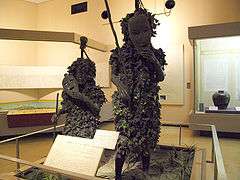 |
Religious festivals and beliefs
66 designations. All were designated under Criteria 1.
| Name | Japanese | Date | Location | Image | Designated |
|---|---|---|---|---|---|
| Procession to Mount Iwaki[25] | 岩木山の登拝行事 | Late July-15 August* | Hirosaki, Aomori |  |
1984 |
| Hirosaki Neputa[26] | 弘前のねぷた | 1–7 August | Hirosaki, Aomori |  |
1980 |
| Aomori Nebuta[27] | 青森のねぶた | 2–7 August | Aomori, Aomori | 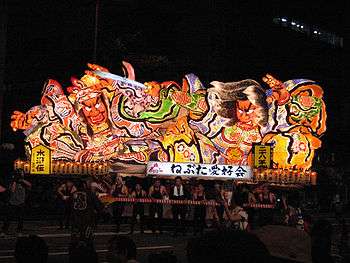 |
1980 |
| Floats of Hachinohe Sansha Taisai[28] | 八戸三社大祭の山車行事 | 1–3 August | Hachinohe, Aomori | 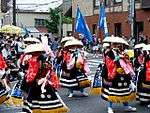 |
2004 |
| Murone Jinja festival[28][29][30] | 室根神社祭のマツリバ行事 | 17–19 September, following a leap year* | Ichinoseki, Iwate | 1985 | |
| Floats of the Hanawa Matsuri (花輪祭の屋台行事 hanawa matsuri no yatai gyōji) | August 19, 20 | Hanawa, Kazuno, Akita | 2014 | ||
| Floats of Kakunodate Matsuri[31] | 角館祭りのやま行事 | 7–9 September | Kakunodate, Akita | 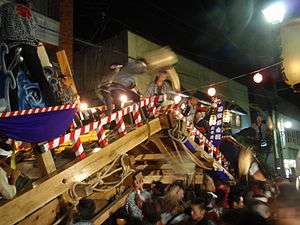 |
1991 |
| Akita Kantō[32] | 秋田の竿灯 | 5–7 August | Akita, Akita |  |
1980 |
| Floats of Tsuchizaki Shinmeishasai[33] | 土崎神明社祭の曳山行事 | 20–21 July | Akita, Akita |  |
1997 |
| Tōkoyasaka Jinja tōnin gyōji|[34] | 東湖八坂神社のトウニン(統人)行事 | 7 July Various | Katagami, Akita | 1986 | |
| shōreisai no ōtaimatsu gyōji (松例祭の大松明行事) | December 31 and January 1 | Dewa Sanzan, Tsuruoka, Yamagata | 2014 | ||
| Floats of Shinjō Matsuri[35] | 新庄まつりの山車行事 | 24–26 August | Shinjō, Yamagata | 2009 | |
| Kanazawa's Hayama Gomori[36] | 金沢の羽山ごもり | 16–18 November* | Fukushima, Fukushima | 1980 | |
| Tajima Gion Festival[37] | 田島祇園祭のおとうや行事 | 18–21 July | Minamiaizu, Fukushima | 1981 | |
| Hitachi Float Procession[38] | 日立風流物 | 3–5 May | Minamiaizu, Ibaraki | 1977 | |
| Karasuyama Yamaage[39] | 烏山の山あげ行事 | 25–27 July | Nasukarasuyama, Tochigi | 1979 | |
| Floats of Kanuma Imamiya Shrine[40] | 鹿沼今宮神社祭の屋台行事 | 2nd weekend of November | Kanuma, Tochigi | 2003 | |
| Hokkōji no gōhanshiki (発光路の強飯式) | 3 January | Kanuma, Tochigi | 1996 | ||
| Katashina Monkey Chasing Festival[41] | 片品の猿追い祭 | Mid-September* | Katashina, Gunma | 2000 | |
| Floats of Kawagoe Hikagawa Shrine[42] | 川越氷川祭の山車行事 | 3rd weekend, October | Kawagoe, Saitama |  |
2005 |
| Music and Floats of the Chichibu Festival[43] | 秩父祭の屋台行事と神楽 | 3, 6 December | Chichibu, Saitama | 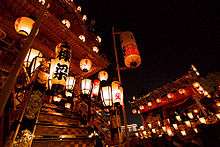 |
1979 |
| Floats of Sawara[44] | 佐原の山車行事 | 18–18 November | Katori, Chiba | |
2004 |
| Shiramazu Grand Festival[45] | 白間津のオオマチ(大祭)行事 | 23–25 July, every 4 years | Minamibōsō, Chiba | 1992 | |
| Mona Satoimo Festival[46] | 茂名の里芋祭 | 19–21 February | Tateyama, Chiba | 2005 | |
| sanpoku no botamochi matsuri (山北のボタモチ祭り) | December 2 (Nakahama and Sugitaira), January 12 (Ganjiki) | Murakami, Niigata | 1999 | ||
| Kibune Shrine Boat Festival[47] | 貴船神社の船祭り | 27–28 July | Manazuru, Kanagawa | 1996 | |
| Namerikawa Nebuta Nagashi[48] | 滑川のネブタ流し | 31 July | Namerikawa, Toyama | 1999 | |
| Uozu Tatemon Festival[49] | 魚津のタテモン行事 | 7–8 August | Uozu, Toyama |  |
1997 |
| Takaoka Float Procession[50] | 高岡御車山祭の御車山行事 | 1 May | Takaoka, Toyama | 1979 | |
| Floats of Jōhana Shinmei Shrine[51] | 城端神明宮祭の曳山行事 | 4–5 May | Nanto, Toyama | 2002 | |
| The Customs of the Keta Uma Festival[52] | 気多の鵜祭の習俗 | 16 December | Hakui, Ishikawa | 2000 | |
| Wakabata Procession of the Kumakabuto Festival[53] | 熊甲二十日祭の枠旗行事 | 20 September | Nanao, Ishikawa | 1981 | |
| Floats of the Seihaku Festival[54] | 青柏祭の曳山行事 | 13–15 May | Nanao, Ishikawa |  |
1983 |
| yoshida no hi matsuri (吉田の火祭) | 26–August 26, 27 | Fujiyoshida, Yamanashi | |
2012 | |
| Kosuge Hashiramatsu Festival[55] | 小菅の柱松行事 | Weekend following 14 July, every 3 years | Iiyama, Nagano | 2011 | |
| Floats and Drums of Furukawa Festival[56] | 古川祭の起し太鼓・屋台行事 | 19–20 April | Hida, Gifu |  |
1980 |
| Floats of Takayama Festival[57] | 高山祭の屋台行事 | 14–15 April, 9–10 October | Takayama, Gifu | 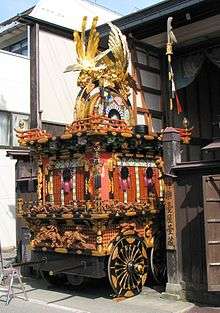 |
1979 |
| Ōgaki Festival Yama Floats Procession[58] | 大垣祭の軕行事 | 10 the weekend before May 15 | Ōgaki, Gifu | 2015 | |
| Mitsuke Tenjin Hadaka Matsuri[59] | 見付天神裸祭 | Weekend preceding 10 August* | Iwata, Shizuoka | 2000 | |
| Boat Procession of Ōe Hachiman Shrine[60] | 大江八幡神社の御船行事 | 15 August | Makinohara, Shizuoka | 1999 | |
| Floats of Kamezaki Shiohi Festival[61] | 亀崎潮干祭の山車行事 | 3–4 May | Handa, Aichi | 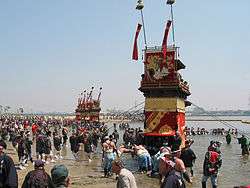 |
2006 |
| Floats of the Inuyama Festival[62] | 犬山祭の車山行事 | 1st weekend of April | Inuyama, Aichi | |
2006 |
| Sunari Festival[63] | 須成祭の車楽船行事と神葭流し | early July to late October, festival eve on first Saturday in August | Tomiyoshitatehaya Shrine, Kanie, Aichi | |
2012 |
| Boats of the Owari Tsushima Tennō Festival[64] | 尾張津島天王祭の車楽舟行事 | 4th weekend of July | Tsushima, Aichi | |
1980 |
| Chiryū Festival[65] | 知立の山車文楽とからくり | 2-3 May | Chiryū, Aichi | |
1990 |
| The Oni Festival of Toyohashi Shinmei Shrine[66] | 豊橋神明社の鬼祭 | 10–11 February | Toyohashi, Aichi | 1980 | |
| Floats of the Kuwana Ishidori Festival[67] | 桑名石取祭の祭車行事 | 1st weekend of August | Kuwana, Mie | |
2007 |
| Danjiri of the Ueno Tenjin Festival[68] | 上野天神祭のダンジリ行事 | 23–25 October | Iga, Mie | |
2002 |
| Whaling Floats of Toride Shrine[69] | 鳥出神社の鯨船行事 | 14–15 August | Yokkaichi, Mie | 1997 | |
| Potato Contest of Ōmi Nakayama[70][71] | Ōmi Nakayama no Imo-kurabe Matsuri (近江中山の芋競べ祭り) taro comparison festival or "potato contest"; Association for the Preservation of the Imo Kurabe Festival (芋くらべ祭保存会) | September 1 | Hino, Shiga | 1991 | |
| Mikami Zuiki Festival[72] | 三上のずいき祭 | Mid-October | Yasu, Shiga | 2005 | |
| Floats of the Nagahama Hikiyama Festival[73] | 長浜曳山祭の曳山行事 | 13–16 April | Nagahama, Shiga | 1979 | |
| Yamaboko Floats of the Kyoto Gion Matsuri[74] | 京都祇園祭の山鉾行事 | July | Kyoto |  |
1979 |
| Miyaza of Wakide Shrine[75] | 涌出宮の宮座行事 | Various | Kizugawa, Kyoto | 1986 | |
| Sakoshi boat festival | sakoshi no funa matsuri (坂越の船祭) | second weekend in October | Sakoshi, Akō, Hyōgo |  |
2012 |
| Boats of the Kōchi Festival[76] | 河内祭の御舟行事 | 24–25 July | Kushimoto, Wakayama | 1999 | |
| Shingū Hayatama Festival Otō Fire Festival[77] | 新宮の速玉祭・御燈祭り | 6–7 February | Shingū, Wakayama | 2016 | |
| Nachi Fire Festival[78] | 那智の扇祭り | 13–14 July | Nachikatsuura, Wakayama | 2015 | |
| Tobata Gion Yamagasa festival[79] | 戸畑祇園大山笠行事 | 13–15 July | Kitakyushu, Fukuoka |  |
1980 |
| Saidaiji Eyō Nakedness Festival[80] | 西大寺の会陽 | 3rd Saturday of February | Okayama, Okayama | 2016 | |
| Pine Festival of Tokakuji Temple[81] | 等覚寺の松会 | 3 April | Kanda, Fukuoka | 1998 | |
| Hakata Gion Yamagasa Festival[82] | 博多祇園山笠行事 | 1–15 July | Fukuoka, Fukuoka |  |
1979 |
| Floats of the Katsura Kunchi Festival[83] | 唐津くんちの曳山行事 | 2–4 November | Karatsu, Saga |  |
1980 |
| Yatsushiro Myoken Shinkō Festival[84] | 八代妙見祭の神幸行事 | 22–23 November | Yatsushiro, Kumamoto | 2011 | |
| Floats of the Hita Gion Festival[85] | 日田祗園の曳山行事 | Weekend following 20 July | Hita, Ōita |  |
1996 |
| Shioya Ungami Sea Festival[86] | 塩屋湾のウンガミ | First day of gai following Obon* | Ōgimi, Okinawa | 1997 |
Those dates marked with an * follow the traditional calendar.
Folk performing arts
Kagura
Kagura (神楽 kagura) (lit. "god entertainment") are dances associated with Shinto shrines.
There have been 35 designations, all under Criteria 1, unless otherwise indicated.
| Name | Japanese | Location | Image | Designated |
|---|---|---|---|---|
| Noh Dance of Shimokita | 下北の能舞 | Shimokita District, Aomori | 1989 | |
| Unotori Dance | 鵜鳥神楽 | Unotori Shrine, Fudai, Iwate | 2015 (criteria 2, 3) | |
| Kuromori Kagura | 黒森神楽 | Miyako, Iwate | 2006 | |
| Hayachine Kagura | 早池峰神楽 | Hanamaki, Iwate | 1976 | |
| Ogatsuhōin Kagura | 雄勝法印神楽 | Ishinomaki, Miyagi | 1996 | |
| Nekko Bangaku | 根子番楽 | Kita-Akita, Akita | 2004 | |
| Horōsan no Shimotsuki Kagura | 保呂羽山の霜月神楽 | Yokote, Akita | 1977 | |
| Honkai-bangaku Lion dance | 本海獅子舞番楽 | Akita Prefecture | 2011 (criteria 2, 3) | |
| Sugisawa Hiyama | 杉沢比山 | Yuza, Yamagata | 1978 | |
| Tamashiki Shrine Kagura | 玉敷神社神楽 | Kisai, Saitama | 2008 | |
| Washi no Miya Saibara Kagura | 鷲宮催馬楽神楽 | Washimiya, Saitama | 1976 | |
| Edo no Sato Kagura | 江戸の里神楽 | Tokyo | 1994 | |
| Tōyama Shimotsuki Matsuri | 遠山の霜月祭 | Iida, Nagano | 1979 | |
| Tenryū Shimotsuki Kagura | 天竜村の霜月神楽 | Tenryū, Nagano | 1978 | |
| Hana Matsuri | 花祭 | Kitashitara District, Aichi |  |
1976 |
| Ise Daikagura | 伊勢太神楽 | Kuwana, Mie | 1981 | |
| Okashira Shinji | 御頭神事 | Ise, Mie | 1977 | |
| Ama Fūryū Odori Kōdori | 阿万の風流大踊小踊 | Minamiawaji, Hyōgo Prefecture | 2011 (criteria 2, 3) | |
| Sada Shin Noh | 佐陀神能 | Matsue, Shimane | 1976 | |
| Ōmoto Kagura | 大元神楽 | Western Shimane | 1979 | |
| Ōdochi Kagura | 大土地神楽 | Izumo, Shimane | 2005 | |
| Bitchu Kagura | 備中神楽 | Okayama | 1979 | |
| Hibakōjin Kagura | 比婆荒神神楽 | Hiba District, Hiroshima | 1979 | |
| Iwakuni Yukaba no Kanmai | 岩国行波の神舞 | Iwakuni, Yamaguchi | 1979 | |
| Mitsukuri Kagura | 三作神楽 | Shunan, Yamaguchi | 2000 | |
| Iyo Kagura | 伊予神楽 | Kihoku, Ehime | 1981 | |
| Tosa Kagura | 土佐の神楽 | Kōchi | 1980 | |
| Iki Kagura | 壱岐神楽 | Iki, Nagasaki | 1987 | |
| Hirado Kagura | 平戸神楽 | Hirado, Nagasaki | 1987 | |
| Kuma Kagura | 球磨神楽 | Kumamoto Prefecture | 2013 (criteria 2, 3) | |
| Ondake Kagura | 御嶽神楽 | Bungo-ōno, Ōita | 2007 | |
| Takaharu Kanme | 高原の神舞 | Takaharu, Miyazaki | 2010 | |
| Takachiho Night Kagura | 高千穂の夜神楽 | Takachiho, Miyazaki | 1978 | |
| Shiiba Kagura | 椎葉神楽 | Shiiba, Miyazaki |  |
1991 |
| Mera Kagura | 米良神楽 | Saito, Miyazaki | 1977 |
Dengaku
Dengaku (田楽 dengaku) (lit. "field music") are musical presentations/dances related to rice planting.
There have been 25 designations, all under Criteria 1 unless otherwise indicated
| Name | Japanese | Location | Image | Designated |
|---|---|---|---|---|
| Hachinohe Emburi | 八戸のえんぶり | Hachinohe, Aomori | 1979 | |
| Yamaya Taue Odori | 山屋の田植踊 | Shiwa, Iwate | 1981 | |
| Akiu Taue Odori | 秋保の田植踊 | Sendai | 1976 | |
| Gohōden Chigo Dengaku and Customs | 御宝殿の稚児田楽・風流 | Iwaki, Fukushima | 1976 | |
| Ishii Shichifukujin and Taue Odori | 石井の七福神と田植踊 | Nihonmatsu, Fukushima | 1995 | |
| Tsutsukowake Shrine Otaue | 都々古別神社の御田植 | Tanagura, Fukushima | 2004 | |
| Itabashi Taasobi | 板橋の田遊び | Itabashi, Tokyo | 1976 | |
| Mizuumi Dengaku and Nōmai | 水海の田楽・能舞 | Ikeda, Fukui |  |
1976 |
| Mutsuki Shinji | 睦月神事 | Fukui, Fukui | 1978 | |
| Gero Ta-no-Kami Festival | 下呂の田の神祭 | Gero, Gifu | 1981 | |
| Nishiure Dengaku | 西浦の田楽 | Hamamatsu, Shizuoka | 1976 | |
| Fujimori Taasobi | 藤守の田遊び | Yaizu, Shizuoka | 1977 | |
| Hirugaya Taasobi | 蛭ヶ谷の田遊び | Shizuoka Prefecture | 2012 (criteria 2, 3) | |
| Mikawa Dengaku | 三河の田楽 | Shitara, Aichi | 1978 | |
| Isobe Omita | 磯部の御神田 | Shima, Mie | |
1990 |
| Tawara Onda | 田原の御田 | Nantan, Kyoto | 2000 | |
| Sumiyoshi Otaue | 住吉の御田植 | Osaka | 1979 | |
| Hanazono Ondamai | 花園の御田舞 | Katsuragi, Wakayama | 1981 | |
| Suginohara Ondamai | 杉野原の御田舞 | Aridagawa, Wakayama | 1987 | |
| Nachi Dengaku | 那智の田楽 | Nachikatsuura, Wakayama | 1976 | |
| Oki Dengaku and Niwa no Mai | 隠岐の田楽と庭の舞 | Nishinoshima, Shimane | 1992 | |
| Aki Hayashida | 安芸のはやし田 | Yamagata District, Hiroshima | 1997 | |
| Shiohara Daisen Kuyō Taue | 塩原の大山供養田植 | Shōbara, Hiroshima | 2002 | |
| Kiragawa Onta Matsuri | 吉良川の御田祭 | Muroto, Kōchi | 1977 | |
| Shirahige Shrine Dengaku | 白鬚神社の田楽 | Saga, Saga | 2000 |
Fūryū
Fūryū Odori (風流踊 fūryū odori) (lit. "elegant dances") are traditional folk dances often consisting of large processions of participants typically wearing colorful costumes and accompanied by props. Another form represented below is Nenbutsu Odori (念仏踊 nenbutsu odori) and the syncretic Nenbutsu Fūryū (念仏風流 nenbutsu fūryū). In these dances, dancing is accompanied by Buddhist chanting and hymns.
The most common surviving example of these dances is the Bon Odori.
There have been 35 designations, all designated under Criteria 1 unless otherwise indicated.
| Name | Description/Remarks | Location | Image | Designated | Reference |
|---|---|---|---|---|---|
| Nagai Great Nenbutsu Sword Dance 永井の大念仏剣舞 Nagai Dainenbutsu Kenbai |
Morioka, Iwate | 1980 | |||
| Oni Sword Dance 鬼剣舞 Oni Kenbai |
A dance in which a small number of dancers wearing samurai armor and oni masks dance and stomp on the ground. The oni represent local protectors, scaring away evil spirits. | Kitakami, Iwate | 1993 | ||
| Nishimonai Bon Odori 西馬音内の盆踊 Nishimonai no Bon Odori |
Ugo, Akita | 1981 | |||
| Kemanai Bon Odori 毛馬内の盆踊 Kemanai no Bon Odori |
Kazuno, Akita | 1998 | |||
| Shimohirai Phoenix Dance 下平井の鳳凰の舞 Shimohirai no Hōō no Mai |
Hinode, Tokyo | 2006 | |||
| Ogōchi Kashima Dance 小河内の鹿島踊 Ogōchi no Kashima Odori |
Okutama, Tokyo | 1980 | |||
| Niijima Great Dance 新島の大踊 Niijima no Ōodori |
Niijima, Tokyo | 2005 | |||
| Chakkirako チャッキラコ Chakkirako |
Miura, Kanagawa | 1976 | |||
| Yamakita Omine-iri 山北のお峰入り Yamakita no Omine-iri |
The term Omine-iri (お峰入り) (lit. "entering the mountains") refers to practitioners of Shugendō setting off on pilgrimages. The Yamakita area was a center of such practitioners in the 19th Century.[87] | Yamakita, Kanagawa | 1981 | ||
| Ayako Dance 綾子舞 Ayakomai |
Kashiwazaki, Niigata | 1976 | |||
| Dai no Saka 大の阪 Dai no Saka |
Uonuma, Niigata | 1998 | |||
| Mushōno Great Nenbutsu 無生野の大念仏 Mushōno no Dainenbutsu |
Uenohara, Yamanashi | |
1995 | ||
| Niino Bon Odori 新野の盆踊 Niino no Bon Odori |
Anan, Nagano | 1998 | |||
| Atobe Dancing Nenbutsu 跡部の踊り念仏 Atobe no Odori Nenbutsu |
Saku, Nagano | 2000 | |||
| Wagō Nenbutsu Odori 和合の念仏踊 Wagō no Nenbutsu Odori |
Anan, Nagano | 2014 (criteria 2, 3) | |||
| Gujō Dance 郡上踊 Gujō Odori |
Gujō, Gifu |  |
1996 | ||
| Tokuyama Bon Odori 徳山の盆踊 Tokuyama no Bon Odori |
Kawanehon, Shizuoka | 1987 | |||
| Utōgi Bon Odori 有東木の盆踊 Utōgi no Bon Odori |
Shizuoka, Shizuoka | 1999 | |||
| Ayado Night Nenbutsu and Bon Odori 綾渡の夜念仏と盆踊 Ayado Yonenbutsu to Bon Odori |
Toyota, Aichi | 1997 | |||
| Yasuraibana やすらい花 Yasuraibana |
Kyoto | 1987 | |||
| Kuta Hanagasa Dance 久多の花笠踊 Kuta no Hanagasa Odori |
Kyoto | 1997 | |||
| Kyoto Rokusai Nenbutsu 京都の六斎念仏 Kyōto no Rokusai Nenbutsu |
Kyoto | 1983 | |||
| Totsukawa Great Dance 十津川の大踊 Totsukawa no Ōodori |
Totsukawa, Nara | 1989 | |||
| Tsuwano Yasaka Shrine Sagimai 津和野弥栄神社の鷺舞 Tsuwano Yasaka Jinja no Sagimai |
Tsuwano, Shimane | 1994 | |||
| Ōmiya Dance 大宮踊 Ōmiya Odori |
Maniwa, Okayama | 1997 | |||
| Shiraishi Dance 白石踊 Shiraishi Odori |
Kasaoka, Okayama | 1976 | |||
| Nishiiya God Dance 西祖谷の神代踊 Nishiiya no Jindai Odori |
Miyoshi, Tokushima | 1976 | |||
| Ayako Dance 綾子踊 Ayako Odori |
Mannō, Kagawa | 1976 | |||
| Takimiya Nenbutsu Dance 滝宮の念仏踊 Takimiya no Nenbutsu Odori |
Ayagawa, Kagawa | 1977 | |||
| Takeo Araodori 武雄の荒踊 Takeo no Araodori |
Takeo, Saga | 1977 | |||
| Ōmura Three Dances (Suko Odori, Okita Odori, Kuromaru Odori) 大村の郡三踊(寿古踊・沖田踊・黒丸踊) Ōmura no kōri san odori (suko odori, okita odori, kuromaru odori) |
Ōmura, Nagasaki | 2014 (criteria 2, 3) | |||
| Hirado Jankara 平戸のジャンガラ Hirado no Jankara |
Hirado, Nagasaki | 1997 | |||
| Yoshihirogaku 吉弘楽 Yoshihirogaku |
Kunisaki, Ōita | 1996 | |||
| Gokase Araodori 五ヶ瀬の荒踊 Gokase no Araodori |
Gokase, Miyazaki | 1987 | |||
| Ichiki Tanabata Dance 市来の七夕踊 Ichiki no Tanabata Odori |
Ichikikushikino, Kagoshima | 1981 |
Storytelling
5 designations. All were designated under Criteria 1.
| Name | Japanese | Location | Image | Designated |
|---|---|---|---|---|
| Echizen Manzai | 越前萬歳 | Echizen, Fukui | 1995 | |
| Mikawa Manzai | 三河万歳 | Aichi Prefecture | 1995 | |
| Owari Manzai | 尾張万歳 | Chita, Aichi | 1996 | |
| Daimokutate | 題目立 | Nara, Nara | 1976 | |
| Kōwakamai | 幸若舞 | Miyama, Fukuoka | 1976 |
Ennen and Okonai
Ennen (延年 ennen) (lit. "extend the years") are Buddhist temple entertainments performed at the end of Buddhist services and believed to extend the listeners' lifespans.[88] Okonai (おこない okonai) (lit. "deeds") are Buddhist New Year celebrations in which the evils of the past year are driven away.
There have been 7 designations, all under Criteria 1.
| Name | Japanese | Location | Image | Designated |
|---|---|---|---|---|
| Mōtsūji Ennen | 毛越寺の延年 | Hiraizumi, Iwate | 1977 | |
| Obasama Ennen | 小迫の延年 | Kurihara, Miyagi | 1979 | |
| Kotaki Choukrairo Dance | 小滝のチョウクライロ舞 | Nikaho, Akita | 2004 | |
| Nechiyamadera Ennen | 根知山寺の延年 | Itoigawa, Niigata | 1980 | |
| Nagataki Ennen | 長滝の延年 | Gujō, Gifu | 1977 | |
| Tōtōmi Hiyondori and Okunai | 遠江のひよんどりとおくない | Hamamatsu, Shizuoka | 1994 | |
| Oki Kokubunji Lotus Dance | 隠岐国分寺蓮華会舞 | Okinoshima, Shimane | 1977 |
Entertainment from Abroad and Performance Arts
36 designations. All were designated under Criteria 1.
| Name | Japanese | Location | Image | Designated |
|---|---|---|---|---|
| Dainichidō Bugaku | 大日堂舞楽 | Kazuno, Akita | 1976 | |
| Kurokawa Noh | 黒川能 | Tsuruoka, Yamagata | 1976 | |
| Hayashike Bugaku | 林家舞楽 | Kahoku, Yamagata | 1981 | |
| Tsunabi | 綱火 | Tsukubamirai, Ibaraki | 1976 | |
| Annaka Nakajuku Tōrō Ningyō | 安中中宿の燈篭人形 | Annaka, Gunma | 1977 | |
| Kiraigō | 鬼来迎 | Yokoshibahikari, Chiba | 1976 | |
| Sagami Ningyō Shibai | 相模人形芝居 | Odawara and Atsugi, Kanagawa | 1980 | |
| Sado Ningyō Shibai | 佐渡の人形芝居(文弥人形、説経人形、のろま人形) | Sado, Niigata | 1977 | |
| Itoigawa Bugaku | 糸魚川・能生の舞楽 | Itoigawa, Niigata | 1980 | |
| Yahiko Shrine Lantern Carrying and Buraku | 弥彦神社燈篭おしと舞楽 | Yahiko, Niigata | 1978 | |
| Etchū Chigomai | 越中の稚児舞 | Toyama | 1982 | |
| Oguchi Dekumawashi | 尾口のでくまわし | Hakusan, Ishikawa | 1977 | |
| Itozaki Buddha Dance | 糸崎の仏舞 | Fukui, Fukui | 2004 | |
| Tenzushi Mai Dance | 天津司舞 | Kōfu, Yamanashi | |
1976 |
| Makuwa Ningyō Jōruri | 真桑人形浄瑠璃 | Motosu, Gifu | 1984 | |
| Nōgō Noh and Kyōgen | 能郷の能・狂言 | Motosu, Gifu | 1976 | |
| Tōtōmi Mori Bugaku | 遠江森町の舞楽 | Mori, Shizuoka | 1982 | |
| Chiryū Float Bunraku and Karakuri | 知立の山車文楽とからくり | Chiryū, Aichi | 1990 | |
| Anori Ningyō Shibai | 安乗の人形芝居 | Shima, Mie | 1980 | |
| Saeki Tōrō | 佐伯灯籠 | Kameoka, Kyoto | 2009 | |
| Saga Dainenbutsu Kyōgen | 嵯峨大念仏狂言 | Kyoto | 1986 | |
| Matsunōdera Buddha Dance | 松尾寺の仏舞 | Maizuru, Kyoto | 2004 | |
| Mibu Kyōgen | 壬生狂言 | Kyoto |  |
1976 |
| Jōryōue Bugaku | 聖霊会の舞楽 | Osaka | 1976 | |
| Kuruma Ōtoshi Shrine Fan Dance | 車大歳神社の翁舞 | Kobe |  |
2000 |
| Awaji Ningyō Jōruri | 淡路人形浄瑠璃 | Minamiawaji, Hyōgo | 1976 | |
| Nara Subiko Shrine Fan Dance | 奈良豆比古神社の翁舞 | Nara, Nara | 2000 | |
| Awa Ningyō Jōruri | 阿波人形浄瑠璃 | Tokushima Prefecture | 1999 | |
| Yame Fukushima Tōrō Ningyō | 八女福島の燈篭人形 | Yame, Fukuoka | 1977 | |
| Hachiman Kohyō Shrine Kugutsu Dance and Sumo | 八幡古表神社の傀儡子の舞と相撲 | Yoshitomi, Fukuoka | 1983 | |
| Kikuchi Matsubayashi | 菊池の松囃子 | Kikuchi, Kumamoto | 1998 | |
| Koyō Shrine Kugutsu Dance and Sumo | 古要神社の傀儡子の舞と相撲 | Nakatsu, Ōita | 1983 | |
| Yamanokuchi Bunya Ningyō | 山之口の文弥人形 | Miyakonojō, Miyazaki | 1995 | |
| Shodon Shibaya | 諸鈍芝居 | Setouchi, Kagoshima | 1976 | |
| Tōgō Bunyabushi Ningyō Jōruri | 東郷文弥節人形浄瑠璃 | Satsumasendai, Kagoshima | 2008 | |
| Yoron Jūgoya Odori | 与論の十五夜踊 | Yoron, Kagoshima | 1993 |
Other
16 designations. All were designated under Criteria 1.
| Name | Japanese | Location | Image | Designated |
|---|---|---|---|---|
| Ainu Ancient Dances | アイヌ古式舞踊 | Hokkaido | 1984 | |
| Ame no Miya Shrine Shinji Arts | 雨宮の神事芸能 | Chikuma, Nagano | 1981 | |
| Snow Festival | 雪祭 | Anan, Nagano | 1977 | |
| Nangū Shrine Shinji Arts | 南宮の神事芸能 | Tarui, Gifu | 1979 | |
| Kamikamogawa Sumiyoshi Shrine Shinji Dance | 上鴨川住吉神社神事舞 | Katō, Hyōgo | 1977 | |
| Kasuga Wakamiya Onmatsuri Shinji Arts | 春日若宮おん祭の神事芸能 | Nara, Nara | 1979 | |
| Takezaki Kanzeonji Temple's Shujōe Oni Festival | 竹崎観世音寺修正会鬼祭 | Tara, Saga | 1985 | |
| Nagasaki Kunchi Hono-Odori | 長崎くんちの奉納踊 | Nagasaki, Nagasaki | 1979 | |
| Shujō Oni Festival | 修正鬼会 | Bungotakada, Ōita | 1977 | |
| Ada Shinugu Festival | 安田のシヌグ | Kunigami, Okinawa | 1978 | |
| Iejima Folk Dance | 伊江島の村踊 | Ie, Okinawa | 1998 | |
| Kohamajima Bon, Kitsugan, and Taneduri Festivals | 小浜島の盆、結願祭、種子取祭の芸能 | Kohamajima, Okinawa | 2007 | |
| Iriomote Shichi Festival | 西表島の節祭 | Iriomote, Okinawa | 1991 | |
| Tarama Hōnensai Festival | 多良間の豊年祭 | Tarama, Okinawa | 1976 | |
| Taketomi Taneduri Festival | 竹富島の種子取 | Taketomi, Okinawa | 1977 | |
| Yonaguni Festival Arts | 与那国島の祭事の芸能 | Yonaguni, Okinawa | 1985 |
Folk Techniques
Manufacturing and Production
11 designations.
| Name | Criteria | Remarks | Location | Image |
|---|---|---|---|---|
| Manufacture technology of Japanese-style ships in the Tsugaru Strait and surrounding area (津軽海峡及び周辺地域における和船製作技術 Tsugaru kaikyō oyobi shūhen chiiki ni okeru wasen seisaku gijutsu) | 2, 3 | Tsugaru Strait, Aomori | — | |
| Manufacture technology of Itaya baskets in Akita (秋田のイタヤ箕製作技術 Akita no itaya-mi seisaku gijutsu) | 3 | Taiheikurosawa, Akita and Kumoshikari, Kakunodate, Semboku; Akita | — | |
| Manufacture technology of Kōnosu Akamono (red things for good luck) (鴻巣の赤物製作技術 kōnosu no akamono seisaku gijutsu) | 3 | Kōnosu, Saitama | — | |
| Excavation technology of Kazusa (上総掘りの技術 kazusa bori no gijutsu) | 3 | Kazusa, Chiba | — | |
| Manufacture technology of wisteria baskets in Kizumi (木積の藤箕製作技術 Kizumi no fujimi seisaku gijutsu) | 3 | Kizumi, Sōsa, Chiba | — | |
| Manufacture technology of Tarai Bune tub boats in Ogi (小木のたらい舟製作技術 ogi no taraibune seisaku gijutsu) | 3 | Ogi, Sado, Niigata | — | |
| ronden kumanashi no fujimi seisaku gijutsu (論田・熊無の藤箕製作技術) | 3 | Kumanashi, Himi, Toyama | — | |
| Salt-making technology of the agehamashiki method on the Noto Peninsula (能登の揚浜式製塩の技術 Noto no agehamashiki seien no gijutsu) | 2, 3 | Shimizu, Suzu, Ishikawa | — | |
| Nagara River Cormorant fishing craft (長良川の鵜飼漁の技術 nagaragawa no ukairyō no gijutsu) | 2, 3 | Gifu, Gifu Prefecture | — | |
| Manufacture technology of Yoshino barrel-staves (吉野の樽丸製作技術 Yoshino no tarumaru seisaku gijutsu) | 3 | Nara | — | |
| Manufacture technology of hot-springs mineral deposits of Myōban Onsen in Beppu (別府明礬温泉の湯の花製造技術 Beppu Myōban onsen no yu no hana seizō gijutsu) | 3 | Myōban, Beppu, Ōita |  |
Necessities of life
2 designations.
| Name | Criteria | Remarks | Location | Image |
|---|---|---|---|---|
| Manufacture techniques of Etchū Fukuoka sedge-woven hats (越中福岡の菅笠製作技術 Etchū Fukuoka no sugegasa seisaku gijutsu) | 3 | Fukuoka, Takaoka, Toyama | ||
| Manufacture techniques of Enako Bandori (straw raincoats) (江名子バンドリの製作技術 enako bandori noseisaku gijutsu) | 3 | Enako-chō, Takayama, Gifu |
| Wikimedia Commons has media related to Important Intangible Folk Cultural Properties. |
Notes
References
- ↑ 春鍬祭 [Harukuwa matsuri] (in Japanese). Tamamura. Retrieved 2011-06-07.
- ↑ 佐渡の車田植 [Spiral rice planting of Sado] (in Japanese). Niigata Prefecture Sightseeing Association. Retrieved 2011-06-07.
- ↑ "Mibu no Hana Taue, ritual of transplanting rice in Mibu, Hiroshima". UNESCO. Retrieved 26 June 2012.
- ↑ 刈和野の大綱引き [Kariwano tug of war] (in Japanese). Daisen. Retrieved 2011-06-15.
- ↑ "Soma-Nomaoi (Wild Horse Racing)". Japan National Tourism Organization. Retrieved 2011-06-15.
- ↑ "National Designated Important Intangible Folk Cultural Property Good luck is brought by augury for the year. Tug-of-war of Tsuruga-Nishimachi". Japan Foundation for Regional Art Activities. Retrieved 2011-06-15.
- ↑ 但馬久谷の菖蒲綱引き [Tajima Kutani tug of war] (in Japanese). Shin'onsen. Retrieved 2011-06-15.
- ↑ 因幡の菖蒲綱引き [Inaba tug of war] (in Japanese). Tottori. Retrieved 2011-06-15.
- ↑ 上州白久保のお茶講 [Jōshū-shirakubo no ochakō] (PDF) (in Japanese). Nakanojō. Retrieved 2011-05-08.
- ↑ "Protection of Intangible Cultural Heritage in Japan". Asia-Pacific Cultural Centre for UNESCO. Retrieved 2011-05-08.
- ↑ スネカ・ナモミ [Suneka, Namomi] (in Japanese). Iwate Prefecture. Retrieved 2011-04-15.
- ↑ 月浜のえんずのわり [Tsukihama Enzu-no-wari] (in Japanese). Miyagi Prefecture. Retrieved 2011-04-15.
- ↑ "Festivals and events in winter". Tome. Retrieved 2011-04-15.
- ↑ 上郷の小正月行事 [Kamigō no koshōgatsu gyōji] (in Japanese). Nikaho. Retrieved 2011-04-15.
- ↑ "Oga Namahage Festival". Japan National Tourism Organization. Retrieved 2011-04-15.
- ↑ "Namahage". Namahage Museum. Retrieved 2011-04-15.
- ↑ アマハゲ [Amahage] (PDF) (in Japanese). Yamagata Prefecture. Retrieved 2011-04-15.
- ↑ 第39回 雪と火のまつり [39th winter and fire festival] (in Japanese). Mishima. 2011-02-11. Retrieved 2011-04-15.
- ↑ "The Hyakuhatto of Inomata - A Bon Ceremony of Misato". Regional Cultural Asset Portal. Japan Foundation for Regional Art Activities. 2006. Retrieved 2011-04-15.
- ↑
- ↑ "Database of National Cultural Properties". Agency for Cultural Affairs. Retrieved 29 January 2012.
- ↑
- ↑ "Database of National Cultural Properties". Agency for Cultural Affairs. Retrieved 29 January 2012.
- ↑ "Database of National Cultural Properties". Agency for Cultural Affairs. Retrieved 29 January 2012.
- ↑ "Database of National Cultural Properties". Agency for Cultural Affairs. Retrieved 20 March 2011.
- ↑ "Database of National Cultural Properties". Agency for Cultural Affairs. Retrieved 20 March 2011.
- ↑ "Database of National Cultural Properties". Agency for Cultural Affairs. Retrieved 20 March 2011.
- 1 2 "Database of National Cultural Properties". Agency for Cultural Affairs. Retrieved 20 March 2011.
- ↑ "Review of Reviews: Minkan Densho (Folklore) Vol. XV (1951), No. 1" (PDF). Asian Ethnology (formerly Asian Folklore Studies). Nanzan University. 10 (2): 281–327. 1951.
- ↑ "室根神社祭マツリバ行事". Ichinoseki City. Retrieved 20 March 2011.
- ↑ "Database of National Cultural Properties". Agency for Cultural Affairs. Retrieved 20 March 2011.
- ↑ "Database of National Cultural Properties". Agency for Cultural Affairs. Retrieved 20 March 2011.
- ↑ "Database of National Cultural Properties". Agency for Cultural Affairs. Retrieved 20 March 2011.
- ↑ "Database of National Cultural Properties". Agency for Cultural Affairs. Retrieved 20 March 2011.
- ↑ "Database of National Cultural Properties". Agency for Cultural Affairs. Retrieved 20 March 2011.
- ↑ "Database of National Cultural Properties". Agency for Cultural Affairs. Retrieved 20 March 2011.
- ↑ "Database of National Cultural Properties". Agency for Cultural Affairs. Retrieved 29 January 2012.
- ↑ "Database of National Cultural Properties". Agency for Cultural Affairs. Retrieved 29 January 2012.
- ↑ "Database of National Cultural Properties". Agency for Cultural Affairs. Retrieved 29 January 2012.
- ↑ "Database of National Cultural Properties". Agency for Cultural Affairs. Retrieved 29 January 2012.
- ↑ "Database of National Cultural Properties". Agency for Cultural Affairs. Retrieved 29 January 2012.
- ↑ "Database of National Cultural Properties". Agency for Cultural Affairs. Retrieved 29 January 2012.
- ↑ "Database of National Cultural Properties". Agency for Cultural Affairs. Retrieved 29 January 2012.
- ↑ "Database of National Cultural Properties". Agency for Cultural Affairs. Retrieved 29 January 2012.
- ↑ "Database of National Cultural Properties". Agency for Cultural Affairs. Retrieved 29 January 2012.
- ↑ "Database of National Cultural Properties". Agency for Cultural Affairs. Retrieved 29 January 2012.
- ↑ "Database of National Cultural Properties". Agency for Cultural Affairs. Retrieved 29 January 2012.
- ↑ "Database of National Cultural Properties". Agency for Cultural Affairs. Retrieved 29 January 2012.
- ↑ "Database of National Cultural Properties". Agency for Cultural Affairs. Retrieved 29 January 2012.
- ↑ "Database of National Cultural Properties". Agency for Cultural Affairs. Retrieved 29 January 2012.
- ↑ "Database of National Cultural Properties". Agency for Cultural Affairs. Retrieved 29 January 2012.
- ↑ "Database of National Cultural Properties". Agency for Cultural Affairs. Retrieved 29 January 2012.
- ↑ "Database of National Cultural Properties". Agency for Cultural Affairs. Retrieved 29 January 2012.
- ↑ "Database of National Cultural Properties". Agency for Cultural Affairs. Retrieved 29 January 2012.
- ↑ "Database of National Cultural Properties". Agency for Cultural Affairs. Retrieved 29 January 2012.
- ↑ "Database of National Cultural Properties". Agency for Cultural Affairs. Retrieved 29 January 2012.
- ↑ "Database of National Cultural Properties". Agency for Cultural Affairs. Retrieved 29 January 2012.
- ↑ "Database of National Cultural Properties". Agency for Cultural Affairs. Retrieved 20 April 2016.
- ↑ "Database of National Cultural Properties". Agency for Cultural Affairs. Retrieved 29 January 2012.
- ↑ "Database of National Cultural Properties". Agency for Cultural Affairs. Retrieved 29 January 2012.
- ↑ "Database of National Cultural Properties". Agency for Cultural Affairs. Retrieved 29 January 2012.
- ↑ "Database of National Cultural Properties". Agency for Cultural Affairs. Retrieved 29 January 2012.
- ↑ "Database of National Cultural Properties". Agency for Cultural Affairs. Retrieved 2 August 2015.
- ↑ "Database of National Cultural Properties". Agency for Cultural Affairs. Retrieved 29 January 2012.
- ↑ "Database of National Cultural Properties". Agency for Cultural Affairs. Retrieved 27 July 2015.
- ↑ "Database of National Cultural Properties". Agency for Cultural Affairs. Retrieved 29 January 2012.
- ↑ "Database of National Cultural Properties". Agency for Cultural Affairs. Retrieved 29 January 2012.
- ↑ "Database of National Cultural Properties". Agency for Cultural Affairs. Retrieved 29 January 2012.
- ↑ "Database of National Cultural Properties". Agency for Cultural Affairs. Retrieved 29 January 2012.
- ↑ "Imokurabe-Matsuri Festival". Biwako Omiji Tourism Council. Retrieved 2011-06-07.
- ↑
- ↑ "Database of National Cultural Properties". Agency for Cultural Affairs. Retrieved 29 January 2012.
- ↑ "Database of National Cultural Properties". Agency for Cultural Affairs. Retrieved 29 January 2012.
- ↑ "Database of National Cultural Properties". Agency for Cultural Affairs. Retrieved 29 January 2012.
- ↑ "Database of National Cultural Properties". Agency for Cultural Affairs. Retrieved 29 January 2012.
- ↑ "Database of National Cultural Properties". Agency for Cultural Affairs. Retrieved 29 January 2012.
- ↑ "Database of National Cultural Properties". Agency for Cultural Affairs. Retrieved 29 January 2012.
- ↑ "Database of National Cultural Properties". Nachikatsuura town. Retrieved 20 April 2016.
- ↑ "Database of National Cultural Properties". Agency for Cultural Affairs. Retrieved 29 January 2012.
- ↑ "Database of National Cultural Properties". Agency for Cultural Affairs. Retrieved 20 April 2016.
- ↑ "Database of National Cultural Properties". Agency for Cultural Affairs. Retrieved 29 January 2012.
- ↑ "Database of National Cultural Properties". Agency for Cultural Affairs. Retrieved 29 January 2012.
- ↑ "Database of National Cultural Properties". Agency for Cultural Affairs. Retrieved 29 January 2012.
- ↑ "Database of National Cultural Properties". Agency for Cultural Affairs. Retrieved 29 January 2012.
- ↑ "Database of National Cultural Properties". Agency for Cultural Affairs. Retrieved 29 January 2012.
- ↑ "Database of National Cultural Properties". Agency for Cultural Affairs. Retrieved 29 January 2012.
- ↑ http://bunka.nii.ac.jp/SearchDetail.do?heritageId=188812&imageNum=6
- ↑ Terence A. Lancashire (16 December 2011). An Introduction to Japanese Folk Performing Arts: Cracking the Code. Ashgate Publishing, Ltd. p. 97. ISBN 978-1-4094-3133-6. Retrieved 14 December 2012.
External links
| Wikimedia Commons has media related to Important Intangible Folk Cultural Properties. |